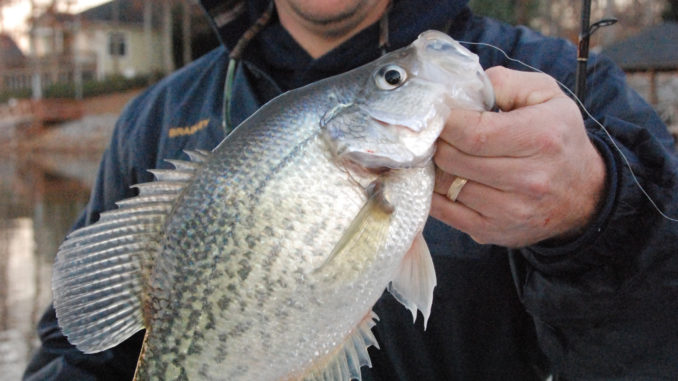
Upper end of lake and major creeks will hold the most slabs in February.
One of the more desirable features about crappie, other than their table qualities, is that these scrappy panfish have a higher metabolism than most freshwater species.
What that means is that when other species turn nearly dormant in the dead of winter, crappie have a continual need to feed on a regular basis. Because they feed on a more-regular basis through the winter, fishermen can enjoy the sport and catch fish — often times a bunch of fish, and big ones to boot — when other anglers are sitting inside re-spooling reels and waiting for spring to arrive.
Some lakes in South Carolina are considered to have better crappie fisheries than others, and of those, some are better suited for winter fishing than summer fishing and vice versa. Crappie on Lake Murray has a very strong following year-round and is also one of the top lakes for winter anglers. That was one of the determining factors for Brad Taylor of Batesburg when he decided to hang out his shingle as a fishing guide and spend plenty of time on Murray.
“A lot of anglers like to fish for crappie in the winter,” said Taylor who operates Taylor Outdoors. “It’s something you need to come dressed for, but there’s no lack of fish and no lack of action.”
Unlike spring fishing, fishing for crappie during the winter allows Taylor to remove nearly three quarters of the lake from the area he’s got to search for crappie.
“The bulk of the crappie fishing that’s going to go on this time of year is in the upper part of the lake, Little River, Big Saluda River, anything above (SC) 391, for the most part,” said Taylor (803-331-1354). “Those fish pile up in the mouths of smaller feeder creeks and are going to be holding from the main-river channel to a point a few hundred yards up in the feeder creek. Not a whole lot of action going on below the forks of the river at this time of the year.”
Not only is the area being fished narrowly defined, but according to Taylor, the methods used to catch them are also pretty narrow. Call it tight-lining, trolling, spider-rigging or any number of terms, but the method Taylor and most other Murray anglers use is slow, vertical trolling, employing multiple rods. Taylor prefers 12-foot lengths, but 18-foot rods are not unheard of. The long rods are evenly spaced in rod holders as the boat slowly and methodically plods along the edge of the channel or open-water flats where crappie lurk.
“Ninety-nine percent of what I do is tight-lining,” he said, “just pushing along at a slow pace, picking up those fish along the channel. When we have one of those hard cold fronts push in, those fish will go to the bottom on deep brush. Then you could tight-line over them, or you could do that Tom Mundy type of fishing.”
On the bait side of things, Taylor uses a combination of live and artificial baits. In crappie circles more than any other type of fishing, that means piggy-backing a live minnow on top of either a hair or rubber-skirted crappie jig. He uses this combination to mimic baitfish that flock to the upper reaches of Lake Murray during the winter.
“Two situations where you’ll find bait,” said Taylor. “You either find it layered out, and then you find it in little pods here and there. The little pods you can catch the fish off of; the big layer, you can’t hardly catch anything, even if the fish are obviously there.”
Taylor’s explanation is that big layers of bait are undisturbed and grouped together en masse for protection. The little pods of bait are what occurs when a predator fish cuts out portions of that layer, making the smaller pods easier targets for the crappie.
“The other way you find bait is by watching the boats,” he said. “When the fish are biting, you’ll see a lot of boats, the local crappie guys, out there trolling back and forth and everybody catching fish.”
Never much for following the crowd, the father-and-son crappie-fishing team of Ellis Cannon and Jon Cannon spend a good bit of time on Lake Murray through the winter. Based in Saluda, the Cannon family (including wife and mom Faye) host the South Carolina Crappie Association, a local crappie club that also supports a regional crappie tournament trail.
Unlike Taylor and many of the others, the Cannons are long-liners. They still troll for crappie, but face the opposite direction. That means while others are pushing baits out the front of the boat, the Cannons are pulling jigs behind the boat. The Cannons also go against the standard of only fishing above the forks.
“You can find fish above Black’s Bridge in the Saluda River and in the Little Saluda River,” Jon Cannon said. “But look at it this way: those two rivers offer about the same depth and the same features as many of the creeks down the lake.”
Cannon can be found down the lake in locations like Buffalo, Rocky and Hawleek creeks. In fact, the Cannons will hit a lot of creeks looking for willing fish, and their years of experience prove this out.
“Murray is kind of an odd lake, because you can find fish in a creek one year, let’s say in Hawleek Creek, and we’ll catch a bunch of fish one year, and it might be three years before you find them in that same creek again. The fish kind of migrate from year to year.”
Regardless of where they find crappie, the characteristics that Taylor described still affect the fish; the colder the water, the lower and slower the presentation needs to be. Tight-lining typically gets the nod when crappie hug the bottom, but Cannon still opts for long lining.
“You could switch to a heavier jig, a 1/8-ounce head, but the standard 1/16- also works,” Cannon said. “You just need to move slower. It’s going to depend on the fish, you just got to go slower, but sometimes in water that cold, the fish are lethargic.”
Cannon’s idea of “slow” is to reduce trolling speed from a typical .7 to 1.2 mph in warmer weather to .4 to .5 mph in the winter. Granted, he and his father would much rather find fish suspended up in the water column.
“Ideally, the fish will be in 20 feet of water, and we’re fishing 12 feet deep,” Cannon said. “They’ll be suspended. What they do is target a certain size baitfish, It’s hard to explain, but they’re picking out shad that’s two inches long, not one that’s an inch or 4 inches. You’ll get different size baitfish suspending at different depths sometimes, and the crappie are right in there with them.”
DESTINATION INFORMATION
HOW TO GET THERE: To target the upper half of Lake Murray on the south shores, the easiest public access ramps are located adjacent to SC 378, which runs from Lexington to Saluda:
• Lake Murray Estates Park. On the west end of the lake near Cloud Creek. From SC 378, take SC 391 north to SC 59. Go west on SC 59 and follow the signs to the ramp.
• Riverbend Point Recreation Area. On the southwest side of the lake across from Hawleek Creek. Take SC 378 to SC 400 and go north three miles to the ramp.
• Lake Murray Shores. On the southwest side of the lake near the mouth of Rocky Creek. Take SC 378 and turn north on Holly Ferry Rd. three miles to the ramp.
BEST TACTICS: Late-winter crappie fishing is best on Lake Murray in tributaries that offer around 20 to 25 feet of water at the edge of the main channel. These locations are found in the upper half of the lake and most popularly in the two main rivers that feed the lake. Tight-line trolling, and to an extent, long-line trolling, are the favored tactics to present live and artificial baits. The colder the water, the slower the presentation needs to be and expect much lighter bites. Look for crappie to hold near pods of bait. When feeding or in active moods, crappie may suspend in the 10- to 12-foot depths which breaks bigger layers of bait into smaller pods and will be reflected on sonar.
GUIDES/FISHING INFO: Brad Taylor, Taylor Outdoors, 803-331-1354, www.tayloroutdoors.com; Jon Cannon, South Carolina Crappie Association, www.sccrappie.com; Tom Mundy, Fish Stalker Lures, 864-682-3404, www.fishstalker.com.
ACCOMMODATIONS: Lake Murray Country, 866-SCJEWEL or www.lakemurraycountry.com.
MAPS: Navionics Electronic Charts, 800-848-5896 www.navionics.com; Delorme South Carolina Atlas & Gazetteer, 800-561-5105 www.delorme.com; Fishing Hot Spots, 800-ALLMAPS, www.fishinghotspots.com.

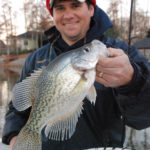
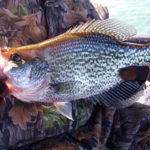
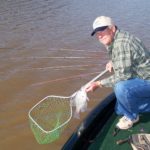
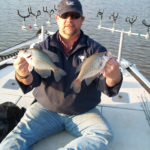

Be the first to comment